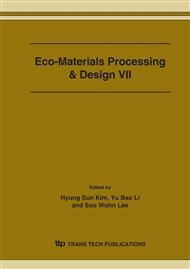p.338
p.342
p.346
p.350
p.354
p.358
p.362
p.366
p.370
Fluidity of A356 Alloy during In-Ladle DTC Rheocasting
Abstract:
There are two primary semisolid processing (S2P) routes, thixocasting and rheocasting. Especially, the rheocasting process has become a new focus in the field of semisolid process because of its many advantages such as increased shot size flexibility, no special SSM billet, inhouse recycling of scrap and smaller investment, compared with the thixoforming process. In-Ladle direct thermal control (DTC) rheocasting was developed, based on the fact that there is slurry and mush transition in molten metal, which is controlled by solid shape and relative interfacial energy. Fluidity is investigated by applying pressure casting for optimizing conditions of in-ladle DTC rheocasting of A356 Al alloy based on research results of simulation and actual microstructure control.
Info:
Periodical:
Pages:
354-357
Citation:
Online since:
March 2006
Authors:
Price:
Сopyright:
© 2006 Trans Tech Publications Ltd. All Rights Reserved
Share:
Citation:


